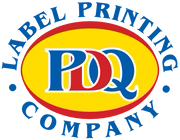
How to Prepare Artwork for Label Printing: Templates, Bleed & Color
Share
Getting labels printed can be exciting - it’s the moment your design becomes something real you can hold in your hands. But before hitting “print,” it’s important to make sure your artwork is set up correctly. A few small details - like using the right template, adding bleed, and setting up your colours - can make all the difference between a perfect label and one that looks a little off.
In this guide, we’ll walk you through the essentials of preparing your artwork for print so your labels come out crisp, accurate, and ready to impress.
And when you’re ready to bring your designs to life, PDQ Labels can help with custom-cut labels, quality materials, and fast, reliable printing.
1. Use the Right Template
Why it matters
A template sets the boundaries for your artwork — the size of the label, shape (circle, rectangle, or custom die-cut), cut lines, trim marks, and layout on a sheet or roll. Using the correct template ensures your design aligns perfectly with the material and printing equipment.
What to check
- Confirm your finished (trimmed) size and label layout (sheet or roll).
- Request or download the exact template from your label printer — it should include guides for cut lines, bleeds, and safe zones.
- Use professional design software such as Adobe Illustrator, InDesign, or CorelDRAW for precision.
- Work in vector format whenever possible to keep logos and text sharp.
How to set it up
For example, if you’re designing a 100 mm × 50 mm die-cut label, set your artboard to that size and add the recommended bleed (usually 2 mm). Include a visible dieline layer and a safe zone for text. Extending backgrounds and patterns slightly beyond the cut line ensures a clean, edge-to-edge finish once printed.
2. Bleed & Safe Zones
What is bleed?
Bleed is the extra margin of your artwork that extends beyond the trim line. It ensures that no unprinted edges appear if the cutting shifts slightly during production.
Safe zone (or type-safe area)
The safe zone is the space inside the trim line where all essential elements — text, logos, key graphics — should stay. Keeping them inside this margin prevents anything important from being cut off.
How much bleed & safe margin to include
- Standard bleed: 2 mm around all sides.
- Safe zone: another 2 mm inside the trim line.
- In imperial terms, that’s roughly 1/16 ″ (bleed) and 1/16 ″ (safe zone).
Best practices
- Extend all backgrounds, colours, and images into the bleed area.
- Keep text and logos inside the safe zone.
- Add a clear, non-printing dieline layer.
- When exporting, include crop and bleed marks.
- Always review spacing between labels if printing multiple per sheet or roll.
3. Colour Setup & File Format
CMYK vs RGB
Printers use CMYK (Cyan, Magenta, Yellow, Black) — not RGB.
If you create artwork in RGB (screen colours), you might notice dull or inaccurate shades after printing. Always convert your file to CMYK before sending it off.
Colour profiles & spot colours
- Check what colour profile your printer recommends (e.g., ISO Coated v2 or FOGRA39).
- Clearly label any Pantone or spot colours used for brand consistency.
- Outline fonts so they don’t change if the printer doesn’t have your font installed.
Resolution & file format
- Minimum image resolution: 300 dpi at final print size.
- Use vector graphics for logos or shapes.
- Export as PDF/X-1a, PDF/X-4, or another print-ready format.
- Embed linked images and ensure nothing is missing from your package.
4. Step-By-Step Workflow
- Confirm label size, material, and layout with your printer.
- Get or create the correct template (including bleed and safe zones).
- Set your document to CMYK colour mode.
- Design your label — extend backgrounds to bleed, keep important details within the safe zone.
- Convert text to outlines and check image resolution.
- Add a separate dieline layer if needed.
- Proof your design carefully — check colours, spacing, and spelling.
- Export as a print-ready PDF with bleed and crop marks.
- Request a digital or physical proof before production.
- Approve and print!
5. Why Work with a Specialist Label Supplier
Partnering with a dedicated label supplier like PDQ Labels saves time and ensures professional quality from start to finish.
- Custom-cut labels to any shape or size
- Choice of materials — gloss, matt, paper, or synthetic
- Expert support for artwork setup and file preparation
- Fast turnaround and reliable service
Whether you’re creating labels for food packaging, cosmetics, or industrial products, PDQ Labels helps you get the details right so your brand stands out on every shelf.
6. Final Checklist for Print-Ready Artwork
Before sending your file to print, go through this quick checklist:
- The document size includes bleed.
- Bleed of at least 2 mm is applied on all sides.
- Safe-zone margins are respected (no text or logos too close to the edge).
- Colour mode is set to CMYK.
- All fonts are outlined or converted to curves.
- Images are high resolution (300 dpi or higher).
- Dieline or cut line layer is clearly indicated and set as non-printing.
- Spot or Pantone colours are properly defined.
- The correct label material and finish are confirmed with your printer.
- Proof has been checked and approved.
7. Summary
Preparing your artwork correctly is the first step toward professional-looking labels. With the right template, bleed setup, and colour accuracy, your printed labels will come out exactly as you envisioned — crisp, clean, and consistent.
When you’re ready to print, PDQ Labels makes it easy. Their team specialises in custom-cut labels, offers expert guidance on file preparation, and uses high-quality materials to make your products shine.



